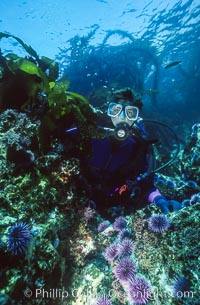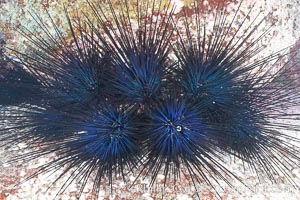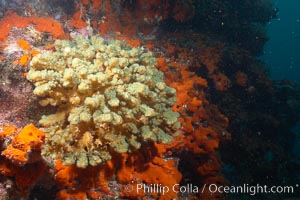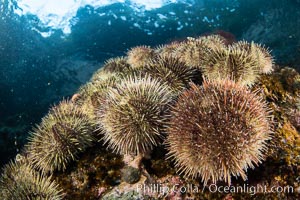
Sea urchins cling to a shallow reef in Browning Pass, Vancouver Island.
Location: British Columbia, Canada
Image ID: 35323
Location: British Columbia, Canada
Image ID: 35323
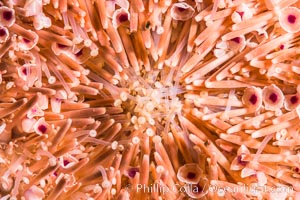
Sea Urchin Detail, Sea of Cortez, Mexico.
Location: Isla San Francisquito, Baja California, Mexico
Image ID: 33648
Location: Isla San Francisquito, Baja California, Mexico
Image ID: 33648
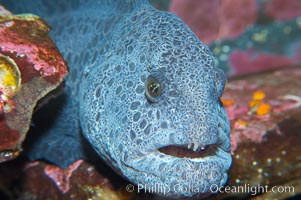
Wolf eel, although similar in shape to eels, is cartilaginous and not a true fish. Its powerful jaws can crush invertibrates, such as spiny sea urchins. It can grow to 6 feet (2m) in length.
Species: Wolf eel, Anarrhichthys ocellatus
Image ID: 13702
Species: Wolf eel, Anarrhichthys ocellatus
Image ID: 13702
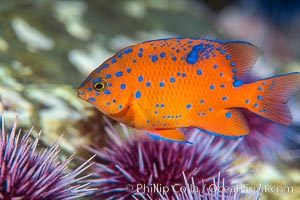
Juvenile garibaldi and purple urchins, Coronado Islands.
Species: Garibaldi, Hypsypops rubicundus, Strongylocentrotus purpuratus
Location: Coronado Islands (Islas Coronado), Baja California, Mexico
Image ID: 02513
Species: Garibaldi, Hypsypops rubicundus, Strongylocentrotus purpuratus
Location: Coronado Islands (Islas Coronado), Baja California, Mexico
Image ID: 02513
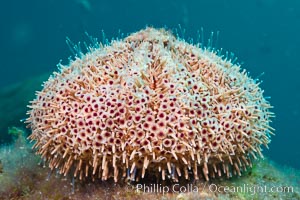
Flower sea urchin with pedicellariae visible.
Species: Flower sea urchin, Toxopneustes roseus
Location: Sea of Cortez, Baja California, Mexico
Image ID: 27528
Species: Flower sea urchin, Toxopneustes roseus
Location: Sea of Cortez, Baja California, Mexico
Image ID: 27528
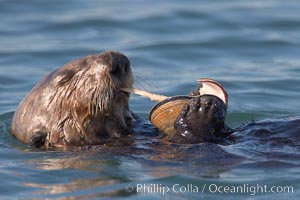
A sea otter eats a clam that it has taken from the shallow sandy bottom of Elkhorn Slough. Because sea otters have such a high metabolic rate, they eat up to 30% of their body weight each day in the form of clams, mussels, urchins, crabs and abalone. Sea otters are the only known tool-using marine mammal, using a stone or old shell to open the shells of their prey as they float on their backs.
Species: Sea otter, Enhydra lutris
Location: Elkhorn Slough National Estuarine Research Reserve, Moss Landing, California
Image ID: 21612
Species: Sea otter, Enhydra lutris
Location: Elkhorn Slough National Estuarine Research Reserve, Moss Landing, California
Image ID: 21612
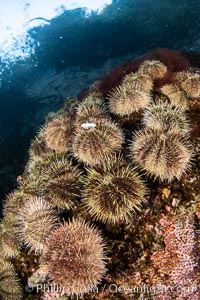
Sea urchins cling to a shallow reef in Browning Pass, Vancouver Island.
Location: British Columbia, Canada
Image ID: 35457
Location: British Columbia, Canada
Image ID: 35457
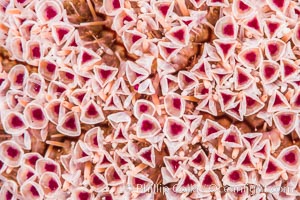
Sea Urchin Detail, Sea of Cortez, Mexico.
Location: Isla San Francisquito, Baja California, Mexico
Image ID: 33647
Location: Isla San Francisquito, Baja California, Mexico
Image ID: 33647
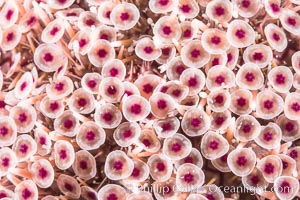
Sea Urchin Detail, Sea of Cortez, Mexico.
Location: Isla San Francisquito, Baja California, Mexico
Image ID: 33649
Location: Isla San Francisquito, Baja California, Mexico
Image ID: 33649
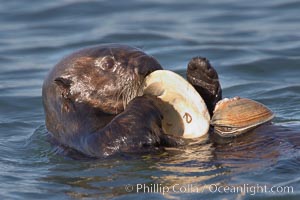
A sea otter eats a clam that it has taken from the shallow sandy bottom of Elkhorn Slough. Because sea otters have such a high metabolic rate, they eat up to 30% of their body weight each day in the form of clams, mussels, urchins, crabs and abalone. Sea otters are the only known tool-using marine mammal, using a stone or old shell to open the shells of their prey as they float on their backs.
Species: Sea otter, Enhydra lutris
Location: Elkhorn Slough National Estuarine Research Reserve, Moss Landing, California
Image ID: 21609
Species: Sea otter, Enhydra lutris
Location: Elkhorn Slough National Estuarine Research Reserve, Moss Landing, California
Image ID: 21609
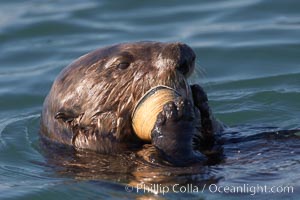
A sea otter eats a clam that it has taken from the shallow sandy bottom of Elkhorn Slough. Because sea otters have such a high metabolic rate, they eat up to 30% of their body weight each day in the form of clams, mussels, urchins, crabs and abalone. Sea otters are the only known tool-using marine mammal, using a stone or old shell to open the shells of their prey as they float on their backs.
Species: Sea otter, Enhydra lutris
Location: Elkhorn Slough National Estuarine Research Reserve, Moss Landing, California
Image ID: 21622
Species: Sea otter, Enhydra lutris
Location: Elkhorn Slough National Estuarine Research Reserve, Moss Landing, California
Image ID: 21622
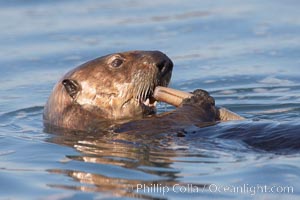
A sea otter eats a clam that it has taken from the shallow sandy bottom of Elkhorn Slough. Because sea otters have such a high metabolic rate, they eat up to 30% of their body weight each day in the form of clams, mussels, urchins, crabs and abalone. Sea otters are the only known tool-using marine mammal, using a stone or old shell to open the shells of their prey as they float on their backs.
Species: Sea otter, Enhydra lutris
Location: Elkhorn Slough National Estuarine Research Reserve, Moss Landing, California
Image ID: 21640
Species: Sea otter, Enhydra lutris
Location: Elkhorn Slough National Estuarine Research Reserve, Moss Landing, California
Image ID: 21640
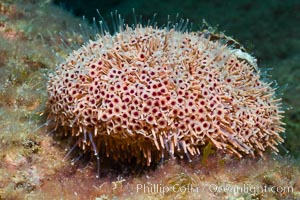
Flower sea urchin with pedicellariae visible.
Species: Flower sea urchin, Toxopneustes roseus
Location: Sea of Cortez, Baja California, Mexico
Image ID: 27533
Species: Flower sea urchin, Toxopneustes roseus
Location: Sea of Cortez, Baja California, Mexico
Image ID: 27533
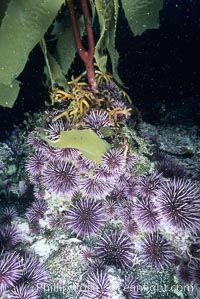
Purple urchins destroying/eating giant kelp holdfast.
Species: Purple urchin, Macrocystis pyrifera, Strongylocentrotus purpuratus
Location: Santa Barbara Island, California
Image ID: 03404
Species: Purple urchin, Macrocystis pyrifera, Strongylocentrotus purpuratus
Location: Santa Barbara Island, California
Image ID: 03404
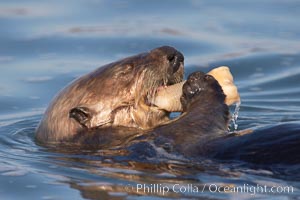
A sea otter eats a clam that it has taken from the shallow sandy bottom of Elkhorn Slough. Because sea otters have such a high metabolic rate, they eat up to 30% of their body weight each day in the form of clams, mussels, urchins, crabs and abalone. Sea otters are the only known tool-using marine mammal, using a stone or old shell to open the shells of their prey as they float on their backs.
Species: Sea otter, Enhydra lutris
Location: Elkhorn Slough National Estuarine Research Reserve, Moss Landing, California
Image ID: 21652
Species: Sea otter, Enhydra lutris
Location: Elkhorn Slough National Estuarine Research Reserve, Moss Landing, California
Image ID: 21652
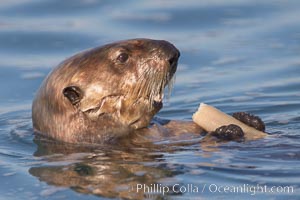
A sea otter eats a clam that it has taken from the shallow sandy bottom of Elkhorn Slough. Because sea otters have such a high metabolic rate, they eat up to 30% of their body weight each day in the form of clams, mussels, urchins, crabs and abalone. Sea otters are the only known tool-using marine mammal, using a stone or old shell to open the shells of their prey as they float on their backs.
Species: Sea otter, Enhydra lutris
Location: Elkhorn Slough National Estuarine Research Reserve, Moss Landing, California
Image ID: 21660
Species: Sea otter, Enhydra lutris
Location: Elkhorn Slough National Estuarine Research Reserve, Moss Landing, California
Image ID: 21660
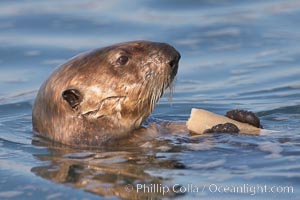
A sea otter eats a clam that it has taken from the shallow sandy bottom of Elkhorn Slough. Because sea otters have such a high metabolic rate, they eat up to 30% of their body weight each day in the form of clams, mussels, urchins, crabs and abalone. Sea otters are the only known tool-using marine mammal, using a stone or old shell to open the shells of their prey as they float on their backs.
Species: Sea otter, Enhydra lutris
Location: Elkhorn Slough National Estuarine Research Reserve, Moss Landing, California
Image ID: 21661
Species: Sea otter, Enhydra lutris
Location: Elkhorn Slough National Estuarine Research Reserve, Moss Landing, California
Image ID: 21661
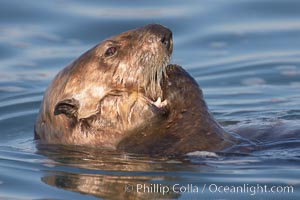
A sea otter eats a clam that it has taken from the shallow sandy bottom of Elkhorn Slough. Because sea otters have such a high metabolic rate, they eat up to 30% of their body weight each day in the form of clams, mussels, urchins, crabs and abalone. Sea otters are the only known tool-using marine mammal, using a stone or old shell to open the shells of their prey as they float on their backs.
Species: Sea otter, Enhydra lutris
Location: Elkhorn Slough National Estuarine Research Reserve, Moss Landing, California
Image ID: 21662
Species: Sea otter, Enhydra lutris
Location: Elkhorn Slough National Estuarine Research Reserve, Moss Landing, California
Image ID: 21662
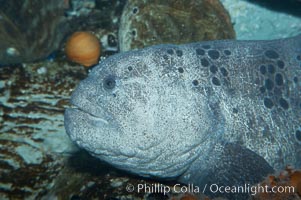
Wolf eel, although similar in shape to eels, is cartilaginous and not a true fish. Its powerful jaws can crush invertibrates, such as spiny sea urchins. It can grow to 6 feet (2m) in length.
Species: Wolf eel, Anarrhichthys ocellatus
Image ID: 11847
Species: Wolf eel, Anarrhichthys ocellatus
Image ID: 11847
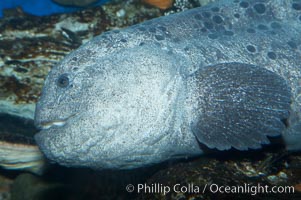
Wolf eel, although similar in shape to eels, is cartilaginous and not a true fish. Its powerful jaws can crush invertibrates, such as spiny sea urchins. It can grow to 6 feet (2m) in length.
Species: Wolf eel, Anarrhichthys ocellatus
Image ID: 11848
Species: Wolf eel, Anarrhichthys ocellatus
Image ID: 11848
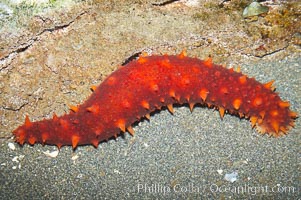
California sea cucumber. Sea cucumbers are related to sea stars and sea urchins. The sharp looking spines are soft to the touch and disappear into the skin when disturbed. If this visual defense doesnt work, the sea cucumber will expel its respiratory system. When this occurs in the wild it can regrow the lost organs.
Species: California sea cucumber, Parastichopus californicus
Image ID: 13732
Species: California sea cucumber, Parastichopus californicus
Image ID: 13732
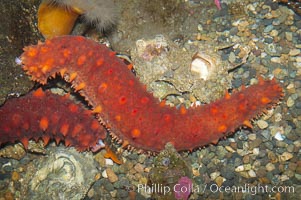
California sea cucumber. Sea cucumbers are related to sea stars and sea urchins. The sharp looking spines are soft to the touch and disappear into the skin when disturbed. If this visual defense doesnt work, the sea cucumber will expel its respiratory system. When this occurs in the wild it can regrow the lost organs.
Species: California sea cucumber, Parastichopus californicus
Image ID: 13733
Species: California sea cucumber, Parastichopus californicus
Image ID: 13733
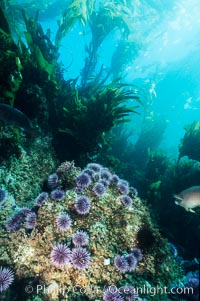
Purple sea urchins on rocky reef amid kelp forest.
Species: Purple urchin, Macrocystis pyrifera, Strongylocentrotus purpuratus
Location: Santa Barbara Island, California
Image ID: 03111
Species: Purple urchin, Macrocystis pyrifera, Strongylocentrotus purpuratus
Location: Santa Barbara Island, California
Image ID: 03111
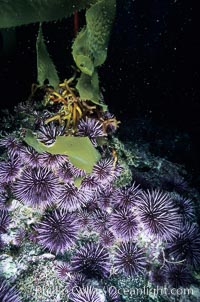
Purple urchins destroying/eating giant kelp holdfast.
Species: Purple urchin, Macrocystis pyrifera, Strongylocentrotus purpuratus
Location: Santa Barbara Island, California
Image ID: 03403
Species: Purple urchin, Macrocystis pyrifera, Strongylocentrotus purpuratus
Location: Santa Barbara Island, California
Image ID: 03403
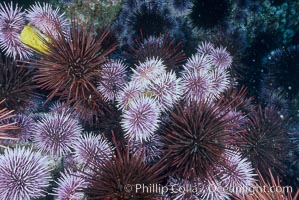
Purple and red urchins.
Species: Purple urchin, Strogylocentrotus franciscanus, Strongylocentrotus purpuratus
Location: Santa Barbara Island, California
Image ID: 04725
Species: Purple urchin, Strogylocentrotus franciscanus, Strongylocentrotus purpuratus
Location: Santa Barbara Island, California
Image ID: 04725
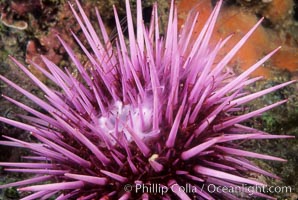
Purple sea urchin, spawning, releasing gametes into the ocean currents. Once adult purple sea urchins have reached sexual maturity, females and males release gametes into the ocean, a mode of external fertilization. The fertilized egg later settles, and begins growing into an adult.
Species: Purple urchin, Strongylocentrotus purpuratus
Image ID: 05346
Species: Purple urchin, Strongylocentrotus purpuratus
Image ID: 05346
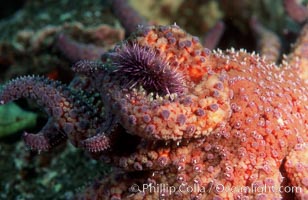
Purple urchin attacked by starfish, Coronados.
Species: Purple urchin, Strongylocentrotus purpuratus
Location: Coronado Islands (Islas Coronado), Baja California, Mexico
Image ID: 01984
Species: Purple urchin, Strongylocentrotus purpuratus
Location: Coronado Islands (Islas Coronado), Baja California, Mexico
Image ID: 01984
